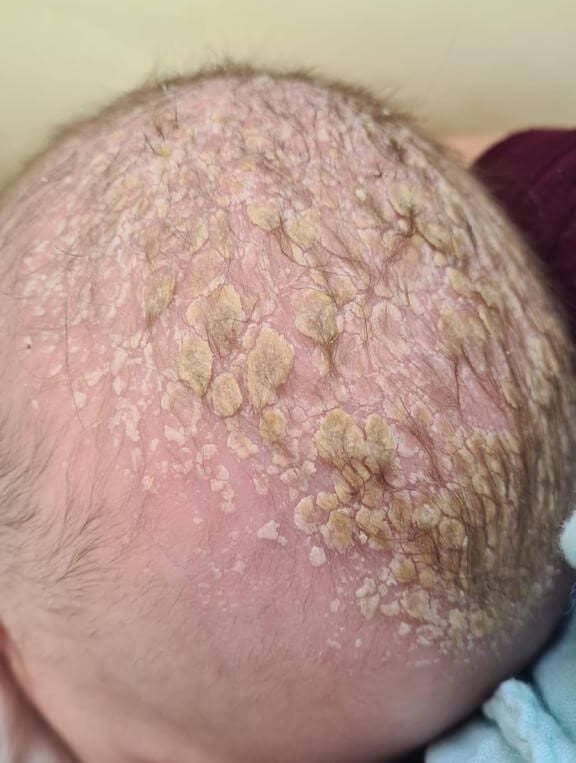
Seborrhea in infants and children
Seborrheic dermatitis (or in short, seborrhea), is inflammation of the skin, that manifests with red lesions, with dandruff on top of them, appearing on parts of the skin that are abundant with sebaceous glands.
The main goal of sebaceous gland is to secret into the hair follicle a fatty material called sebum, hence the name of the inflammation – seborrhea.
Sebaceous glands are found mainly in “seborrheic” areas of the scalp, face, behind the earlobes, the front of the chest and the groin area. These are the areas where we can find the typical rash of seborrhea.
What causes seborrhea in infants and children?
The reason is unknown.
It may be related to a reaction of the body to some form of fungi (Pityrosporum ovale) which can found on the skin of the scalp, but this is uncertain. As you can read ahead, some of the potential treatments include hair products with anti-fungal materials.
When does seborrhea appear?
Seborrhea appears mainly in babies in the first few weeks of life, and in adolescents (and naturally can be found in adults too.)
How do you diagnose seborrhea?
This is a clinical diagnosis, done by the physician after he examines the affected area and sees the typical rash. There is no need for any additional testing.
In babies, seborrhea appears in the first few week of life, with a typical rash on the scalp – patches of oily, yellowish scales and dandruff covering the scalp (this condition is called “Cradle cap”). When the face are involved, we can see the same rash (scaly yellowish flakes) covering the brows, nose bridge and the nasolabial fold and cheeks. In addition, there is a form of seborrhea where the groin area is involved, giving the appearance of diaper dermatitis, only it is more extensive and involves the groin folds (unlike classic diaper dermatitis where the folds are spared, since they do not come in contact with secretions).
In adolescents, the inflammation is mainly on the scalp, which causes what everyone knows as dandruff – on the scalp, eye leads, seborrheic areas on the face (brows, nose bridge, nasolabial folds and cheeks) and sometimes the areas behind the earlobes and the outer part of the auditory canal.
Is seborrhea painful or irritating?
No.
In contrast with atopic dermatitis (read about it here), seborrhea does not cause itchiness. It does not cause any restlessness and does not bother the baby at all. It mainly bothers the parents and the rest of the family. The reason people go to see a physician is mainly cosmetic, and since they have a sense of discomfort from the looks and feel of the oily dandruff.
Is seborrhea dangerous for the short or long term?
No. it usually passes on its own after a few months, as you can read ahead.
Well, I don’t like the fact that my baby has yellow dandruff on his head. What can I do about it?
The first option, which many parents choose after hearing this explanation from the doctor, is to just wait and do nothing. The seborrhea will pass on its own after a few weeks or a little while longer (but most definitely until the baby is one years old).
If you want, you can try removing the oily, scaly dandruff. Try oiling the scalp with baby oil or bath oil, combing the hair with a dense tooth comb and then washing the hair with baby’s shampoo.
You can also use salicylates (Salicylic acid) ointment, to help remove the dandruff from the skin. It will not solve the problem permanently, since these dandruffs will reappear in many cases, but it can certainly help.
In more severe cases, you can try washing the hair with hair products containing anti-fungal materials, and ointments containing anti-fungal materials as well as steroids. Since these hair products can cause dry skin and eye irritations in young babies, we keep these treatment options for the severe cases which doesn’t respond to other treatments.
In conclusion – seborrhea is a common skin inflammation in babies, and is mostly just a cosmetic problem bothering the parents alone. It doesn’t cause any discomfort or itchiness for the baby, and is not dangerous at all. It will pass on its own after a few months, and most of the time doesn’t require any treatment except combing the scaly skin with oil or designated hair products (if you choose to use them).
For comments and questions, please register
